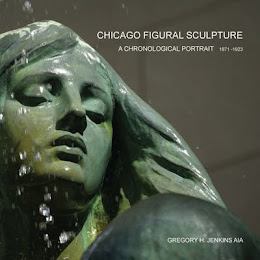.
In 1886 Augustus Saint Gaudens sculpted (in plaster) "Diana of the Tower" an 18' tall weathervane to be fabricated in copper by the W. H. Mullins Company of Salem, Ohio. Once completed, it stood (spun) atop McKim Mead and White's Madison Square Garden in New York City from October 1891 until September of 1892 when it was deemed too large for that location and moved to the Agriculture Building at the Chicago World's Fair.
Saint Gaudens replaced the larger original with a smaller "Diana of the Tower" at Madison Square Garden, where she stood until 1925, when she was acquired by the Philadelphia Art Museum.
The larger, original "Diana of the Tower" suffered after the 1893 Fair. The bottom half of the figure was "lost to fire after the Exposition's close. Location of the upper half is unknown." (Hmmm.)
John Massey Rhind's adaptation of Saint Gaudens "Diana of the Tower," renamed "Progress" was installed on the Ward Michigan Avenue headquarters on October 10, 1900 --- seven years after the Fire at the Exposition. The W.H.Mullins Company, who fabricated Gauden's "Diana" also fabricated Rhind's "Progress."
In 1929 a four storey pyramid was added to the Montgomery Ward Administration Building on West Chicago Avenue by Schmidt Garden and Martin. The now existing "Progress" was installed there at that time. See photos of previous two posts. Mullins and Company may have been the fabricator. Again. Using molds from the original. Which would explain similarities of size and pose.
The original Sculpture of "Progress" was removed from 6 North Michigan Avenue in 1947 (which was not so very long ago) when the tower was demolished. (She disappeared without a trace). A vintage photo confirms that "Progress" was still in place on Michigan Avenue in 1930 -- indicating that both "Progresses" were simultaneously extant. And with that -- one mystery is solved. (If these sources are good.) The Sculpture on West Chicago Avenue was not moved from Ward's Michigan Avenue headquarters. She is a copy. Dressed for the times.
"Progress" became a symbol of Montgomery Ward's. See her in Terra Cotta bas relief in links below. What special attachment did Aaron Montgomery Ward hold for this "Progress?" Why would she occupy the Tower location on Michigan Avenue, and be worth copying - not only on West Chicago Avenue, but throughout the Country?
Speculation begins here. "Progress" is the only nude that I've seen by John Massey Rhind. Her flowing style is not in keeping with his typically heavy, well- balanced figures. But he was of sufficient talent and reputation to repair a Saint Gaudens. A Saint Gaudens heavily damaged by fire. And the collapse of the Agriculture Building following the Fair. A bend of the arm. A leg. Foot. Replace the bow with a spear...... Rebalance her a bit. (Go to, Jyoti. Possible. Maybe?) A Sculpture entirely worthy of Aaron Montgomery Ward. I'd say. She had been, after all, once standing on the tallest building in New York City. Nude. Spotlit and Spinning. Not to mention her importance at the Fair.
.
But just how and why does a Saint Gaudens disappear TWICE.?? And here I will quote Laurence F. Jonson, Curator of the Deere Art Collection in 1990 and entirely familiar with Mullins. (A dreamer maybe, but certainly both educated and connected). "Somewhere.....the proud lady might still stand .... viewing the changing scenes with a wise eye.... as magnificent as when she was first created by....Augustus Saint Gaudens.
I like that.
Follow Exceptional Links Below for Original Photos and resources.
Diana of the Tower
John Deere Heritage
Google Images. 1930
Sharlot Hall Museum
Skyscraper Page
Montgomery Ward
Ohio Antiques
Flickr. Diana
Flickr. Ward Terra Cotta
Flickr. Agriculture Building
New York Times
Building Age. Vol 22
FOR MORE CHICAGO ARCHITECTURE, SCULPTURE, AND PHOTOGRAPHY VISIT
.

















































































